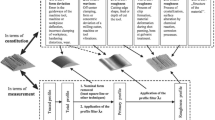Abstract
High product quality is one of key demands of customers in the field of manufacturing such as computer numerical control (CNC) machining. Quality monitoring and prediction is of great importance to assure high-quality or zero defect production. In this work, we consider roughness parameter Ra, profile deviation Pt and roundness deviation RONt of the machined products by a lathe. Intrinsically, these three parameters are much related to the machine spindle parameters of preload, temperature, and rotations per minute (RPMs), while in this paper, spindle vibration and cutting force are taken as inputs and used to predict the three quality parameters. Power spectral density (PSD) based feature extraction, the method to generate compact and well-correlated features, is proposed in details in this paper. Using the efficient features, neural network based machine learning technique turns out to be able to result in high prediction accuracy with R2 score of 0.92 for roughness, 0.86 for profile, and 0.95 for roundness.














Similar content being viewed by others
References
Saravanan S, Yadava GS, Rao PV (2006) Condition monitoring studies on spindle bearing of a lathe. Int J Adv Manuf Technol 28:993–1005
Kumar NS, Shetty A, Shetty A et al (2012) Effect of spindle speed and feed rate on surface roughness of carbon steels in CNC turning. Procedia Eng 38:691–697
Thakkar J, Patel MI (2014) A review on optimization of process parameters for surface roughness and material removal rate for SS 410 material during turning operation. Int J Eng Res Appl 4(2):235–242
Singh M, Gangopadhyay S (2017) Effect of cutting parameter and cutting environment on surface integrity during machining of Nimonic C-263a Ni based superalloy. In: International conference on advances in mechanical, industrial, automation and management systems, Motilal Nehru national institute of technology Allahabad, India, 3–5 February, pp 231–238
Janahiraman TV, Ahmad N (2014) An optimal-pruned extreme learning machine based modeling of surface roughness. In: International conference on information technology and multimedia (ICIMU), Pultrajaya, Malaysia, 18–20 November
Al Hazza MH, Adesta EY, Seder AM (2015) Using soft computing methods as an effective tool in predicting surface roughness. In: 4th international conference on advanced computer science applications and technologies, pp 9–13
Dahbi S, Ezzine L, El Moussami H (2016) Modeling of surface roughness in turning process by using artificial neural networks. In: 3rd international conference on logistics operations management (GOL), 23–25 May
Lu C (2008) Study on prediction of surface quality in machining process. J Mater Process Technol 205:439–450
Fang N, Pai PS, Edwards N (2016) Multidimensional signal processing and modeling with neural networks in metal machining: cutting forces, vibrations, and surface roughness. In: 8th IEEE international conference on communication software and networks, pp 77–80
Zmarzly P (2020) Technological heredity of the turning process. Tech Gaz 27(4):1194–1203
Suneel TS (2010) Intelligent tool path correction for improving accuracy in CNC turning. Int J Prod Res 38(14):3181–3202
Şahinoğlu A, Karabulut Ş, Güllü A (2017) Study on spindle vibration and surface finish in turning of Al 7075. Solid State Phenom 261:321–327
Kamble PD, Waghmare AC, Askhedkar RD et al (2017) Multi objective optimization of turning parameters considering spindle vibration by hybrid Taguchi principle component analysis (HTPCA). Mater Today 4:2077–2084
Shetty VM, Pallapothu M, Pothuganti VR (2015) Experimental analysis on the influence of spindle vibrations of CNC lathe on surface roughness using Taguchi method. Int J Curr Eng Technol 5(2):1273–1276
Chang HK, Kim JH, Kim IH et al (2007) In-process surface roughness prediction using displacement signals from spindle motion. Int J Mach Tools Manuf 47(6):1021–1026
Lee J, Gao W, Shimizu Y et al (2012) Spindle error motion measurement of a large precision roll lathe. Int J Precis Eng Manuf 13(6):861–867
Maračeková M, Zvončan M, Görög A (2012) Effect of clamping pressure on parts inaccuracy in turning. Technicki Vjesnik 19(3):509–512
Alfares MA, Elsharkawy AA (2003) Effects of axial preloading of angular contact ball bearings on the dynamics of a grinding machine spindle system. J Mater Process Technol 136:48–59
Li Y, Zhao W, Lan S et al (2015) A review on spindle thermal error compensation in machine tools. Int J Mach Tools Manuf 95:20–38
Yang H, Ni J (2005) Dynamic neural network modeling for nonlinear, nonstationary machine tool thermally induced error. Int J Mach Tools Manuf 45(4):455–465
Tseng PC, Ho JL (2002) A study of high-precision CNC lathe thermal errors and compensation. Int J Adv Manuf Technol 19:850–858
Stępień K (2014) Research on a surface texture analysis by digital signal processing methods. Teh Vjesn-Tech Gaz 21(3):485–493
Quick guide to surface roughness measurement. Reference guide for laboratory and workshop. https://www.mitutoyo.com/wp-content/uploads/2012/11/1984_Surf_Roughness_PG.pdf.
Scikit-learn user guide, https://scikit-learn.org/stable/_downloads/scikit-learn-docs.pdf.
Yan W, Zhou JH (2018) Early fault detection of aircraft components using flight sensor data. In: IEEE 23rd international conference on emerging technologies and factory automation, Turin, Italy, 4–7 September
Tyagi S, Panigrahi SK (2017) A comparative study of SVM classifiers and artificial neural networks application for rolling element bearing fault diagnosis using wavelet transform preprocessing. J Appl Comput Mech 3(1):80–91
Author information
Authors and Affiliations
Corresponding author
Rights and permissions
About this article
Cite this article
Du, C., Ho, C.L. & Kaminski, J. Prediction of product roughness, profile, and roundness using machine learning techniques for a hard turning process. Adv. Manuf. 9, 206–215 (2021). https://doi.org/10.1007/s40436-021-00345-2
Received:
Revised:
Accepted:
Published:
Issue Date:
DOI: https://doi.org/10.1007/s40436-021-00345-2



